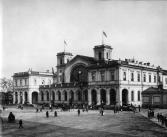The subject index
/
Izmaylovsky Life Guards Regiment
hidden
|
Anna Ioanovna, Empress (1693-1740)
ANNA IOANNOVNA (1693-1740, St. Petersburg), Empress (from 1730). The daughter of Tsar Ivan V, niece of Tsar Peter the Great. In 1710, she married Friedrich Wilhelm, Duke of Courland, and within two months she was widowed
|
|
|
|
|
hidden
|
Baltiysky Railway Station
BALTIYSKY RAILWAY STATION (120 Obvodny Canal Embankment). The station was built in 1853 after a railway between St. Petersburg and Peterhof was completed, and was originally called Peterhofsky Railway Station. Architect A.I
|
|
|
|
|
hidden
|
Decembrist Revolt of 1825
DECEMBRIST REVOLT OF 1825, the first overt armed revolt against autocracy and the ownership of serfs in Russia. It was prepared by the Northern Decembrist Society
|
|
|
|
|
hidden
|
Guards
GUARDS, life guards, elite, privileged military unit. The Russian Guards were established by Peter I in 1700, when the Preobrazhensky and Semenovsky regiments gained the title of life guards
|
|
|
|
|
hidden
|
Guards' Case
GUARDS' CASE (Spring case), one from the series of cases fabricated by the Joint State Political Administration Board against former officers of Imperial and White Armies
|
|
|
|
|
hidden
|
His Majesty's Life-Guards 1st Rifle Regiment
Light infantry along with heavy infantry emerged in European armies in the 18th century. The light infantry consisted of units called rifle units.
The Imperial Rifle Regiment was established in 1854
|
|
|
|
|
hidden
|
Izmailovsky Garden
IZMAILOVSKY GARDEN is situated in the centre of St. Petersburg, between No 114 and 116а Fontanka River Embankment and Derzhavina Lane. The Polsky Garden is located to the west of the lane. The Izmailovsky Garden is 1.3 hectares in size
|
|
|
|
|
hidden
|
Izmaylovsky Avenue
IZMAYLOVSKY AVENUE, running from Fontanka River Embankment to Obvodny Canal Embankment. Called Voznesensky Avenue from the second half of the 18th century to the early 19th century, and Krasnykh Komandirov Street from 1923 to 1944
|
|
|
|
|
hidden
|
Konstantin Konstantinovich, (1858-1915), Grand Prince
KONSTANTIN KONSTANTINOVICH (1858, Strelna - 1915, Pavlovsk), Grand Prince, Infantry General (1907), Adjutant General (1901), honorary member of the St. Petersburg Academy of Sciences (1900). Son of Grand Prince Konstantin Nikolaevich
|
|
|
|
|
hidden
|
Krasnoarmeiskie Streets, First - Thirteenth
KRASNOARMEISKAYA STREETS, FIRST - THIRTEENTH (until 1923, the First - Twelfth Roty, and Zarotnaya Street). First - Seventh Krasnoarmeiskaya Streets are located between Moskovsky Avenue and Izmailovsky Avenue; Eighth Krasnoarmeiskaya Street
|
|
|
|
|
hidden
|
Lvov N.A. (1751-1803), architect
LVOV Nikolay Alexandrovich (1751-1803), architect, poet, engraver, scientist, engineer, privy counsellor, member of the Russian Academy (1783), honorary member of the Academy of Arts (1786). Received a home education
|
|
|
|
|
hidden
|
Military Churches (entry)
MILITARY CHURCHES, churches attached to military units, emerged parallelly with the foundation of the city, set up as field churches in regimental settlements - garrison, infantry and guards quarters
|
|
|
|
|
hidden
|
Moskovskaya Side
MOSKOVSKAYA Side, the 18th century name of the territory on the left bank of the Neva River to the east and south-east from the Fontanka River, that was populated with labourers, brought from Moscow in the early 18th century (hence the name)
|
|
|
|
|
hidden
|
Muravyev M.N. (1757-1807), poet
MURAVYEV Mikhail Nikitich (1757-1807, St. Petersburg), writer, statesman, Privy Councilor (1800), Fellow of the Russian Academy (1804). Father of two Decembrists, N.M. Muravyev and A.M. Muravyev
|
|
|
|
|
hidden
|
Novikov N.I. (1744-1818), journalist, publisher
NOVIKOV Nikolaiy Ivanovich (1744-1818), man of letters, journalist, publisher. Studied in the gymnasium affiliated to the Moscow University (1756-59). From 1762-67 and 1769-79 lived in St. Petersburg
|
|
|
|
|
hidden
|
Officers Houses (entry)
OFFICERS HOUSES, officers houses were stone tenement houses (second half of the 19th - beginning of the 20th centuries), where apartments were rented at low rates solely to the officers rendering military service in one of the garrison's regiments
|
|
|
|
|
hidden
|
Platz - Drill Grounds (entry)
PLATZ (from German "Platz" - square) is a large and flat area (squares, waste grounds) for drills and army training. The first platz (drill square) in St. Petersburg was Mars Field
|
|
|
|
|
hidden
|
Regiment Settlements (entry)
REGIMENT SETTLEMENTS are places for compact billets of guard regiments inside the city limits in the 18th - early 19th century. They were built in 1739-43 under regular designs specially provided for this purpose (usually the planning included an
|
|
|
|
|
hidden
|
Rizhsky Avenue
RIZHSKY AVENUE, between Lermontovsky Avenue and the Ekateringofka River. Since 1776, it was known as Izmailovskaya Street (after Izmailovsky Life Guard Regiment quartered nearby), Izmailovsky Avenue and Novoizmailovsky Avenue, St
|
|
|
|
|
hidden
|
Union for Constituent Assembly Protection
UNION FOR CONSTITUENT ASSEMBLY PROTECTION, established in Petrograd on 23 October (old style: 6 December) 1917, united members of the Mensheviks, Socialist Revolutionaries, People's Socialists, Petrograd Central and Regional Dumas, co-operatives
|
|
|
|
|
|
hidden
|
|
hidden
|
|
hidden
|
|
hidden
|
|
hidden
|
|
hidden
|
|
hidden
|
|
hidden
|
|
hidden
|
|
hidden
|
























